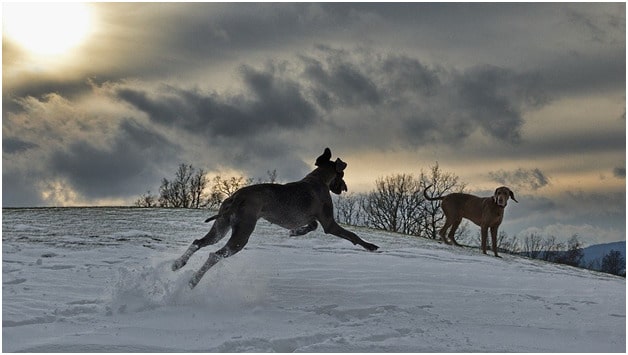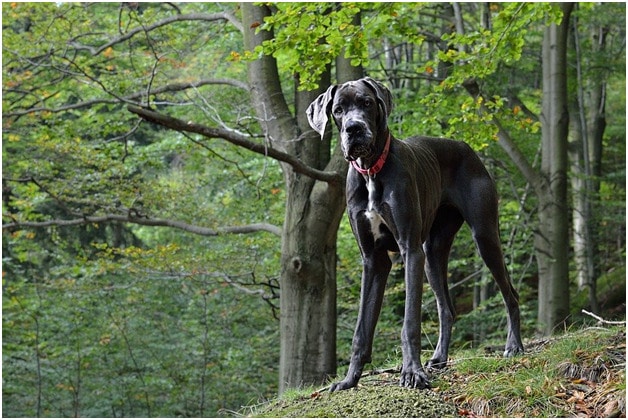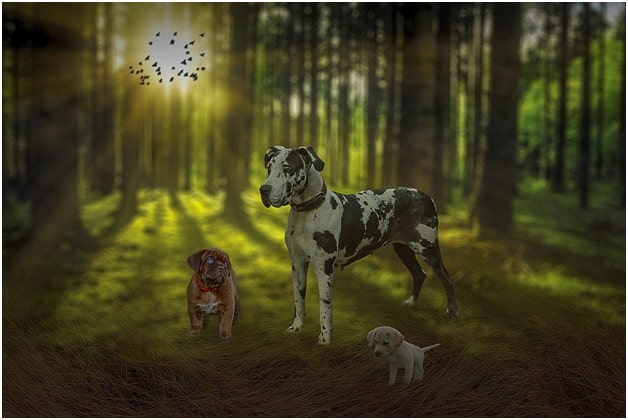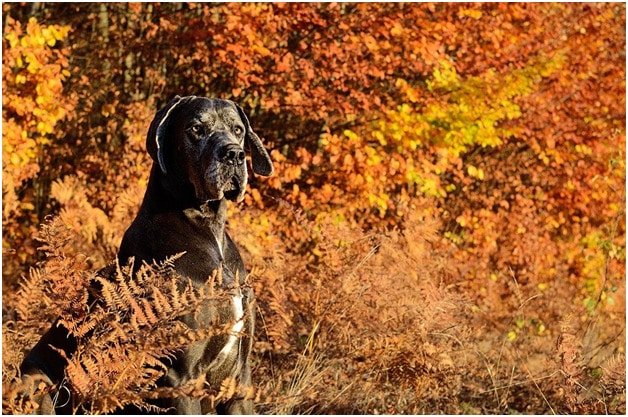Great Danes are without a doubt, one of the world’s tallest and agile breeds. Because of their size, many people assume these dogs are not agile, however, very few put in the time to find out if that is true.
So, are Great Danes agile?
Despite their size and weight (weight ranges between 100 and 200 pounds), Great Danes are very agile dogs. With the right training and trainer, Great Danes can be some of the most agile dogs, regardless of how big and tall they may be!
If you are ready to learn more about Great Danes and their agility, be sure to stick around until the end of the article as we answer all your burning questions!
Are Great Danes Built for Agility?
Great Danes are among the world’s tallest dog breeds, but they are also one of the most agile. They have a light and lean build that makes them perfect for racing around an agility course.
But Great Dane owners should be aware that these dogs need to get plenty of exercise before being unleashed on any sort of obstacle course.
If you want your Great Dane to thrive in agility competitions, start training early and take it on long walks or jogs every day to maintain its health.
Danes are very intelligent dogs which means they can easily learn new tricks with just a little patience from their owner. This intelligence also allows them to grasp difficult concepts when it comes to agility training like jumping over obstacles, going through tunnels, and climbing up ramps.
Therefore, despite the inconvenience of their large size, these dogs have flexible bodies and a high IQ level, making them more or less suited for agility!
At What Age Should Great Dane Agility Begin?

The earliest age to start agility training depends on the dog’s size and physical maturity. Generally, any dog under 18 months of age should not partake in this activity.
Agility training can be started after that, but it’s important to monitor the dog’s health and weight throughout their life and adjust exercise accordingly.
The reason that young dogs aren’t recommended for this type of exercise is not that they’re too immature to handle it, but rather because it can stress their joints.
Doing any type of strenuous activity before the dog’s skeletal system has fully developed will increase the chances of developing joint problems later in life.
Great Danes have a very large bone structure so are at increased risk of suffering from hip dysplasia if they don’t get enough calcium and vitamin D, which promotes strong bones.
When you first take your Great Dane puppy home, make sure that you feed them high-quality food containing calcium supplements. This should ideally be done until the end of their first year at least.
If your dog seems to become tired during exercises or training sessions, take a break. It’s better to have several shorter training sessions throughout the day rather than one long one.
Is Agility Good for Great Danes?
If you are a Great Dane owner considering starting agility with your dog, it is normal for you to wonder if agility is good for Great Danes, or even safe to try, in the first place. Thankfully, we have those answers too!
Agility is a great way to give your Great Dane some well-deserved exercise and mental stimulation. It also gives you the opportunity to bond with your dog as it learns new things. In addition, agility can help increase your pet’s confidence as well as its trust in you as a handler.
In order to do this, make sure that you are positively reinforcing everything that your pup does correctly on the course by giving them lots of praise and treats.
There are several ways of teaching an adult Great Dane how to do agility courses. These include having him go through the course on his own first while walking next to him at all times.
You should also gradually introduce him to each obstacle before taking him around it on his own. Teaching him how to go over a variety of surfaces is also recommended, including asphalt, grass, and hay bale mats.
Finally, teach him to go over jumps sideways or diagonally before going forward straight over them.
Great Dane Agility Training – Potential Concerns
If you’re thinking of teaching your Great Dane some agility tricks, there are many things to consider first before jumping in feet first.
Not all breeds can do agility to the same degree. For instance, because of their enormous body size, it would be very difficult for them to jump over high obstacles or slalom between cones on a running track.
However, they can easily lie down and roll around when asked to do so (although this isn’t an official competition skill).
If you want your dog to learn any advanced skills like that mentioned above then look out for equipment that has specifically designed with giant breeds in mind. For example, a raised jump will need to be quite high compared with those barriers used by smaller breeds of dog.
A standard 12” high obstacle would be too easy for a Great Dane and may even encourage it to start jumping over obstacles that aren’t there!
Great Danes also tend to have very poor eyesight, which makes it difficult for them to see objects from a distance. This means that you’re going to have to get up close and personal with the equipment before asking your pet dog to learn any new tricks or stunts.
They can never be allowed into free space until they are completely confident about what they are doing – because once they make a mistake it could result in injury for both them and anyone else who is standing nearby.
Great Danes are also very sensitive to noise, which can be a problem if you’re thinking of taking your furry friend to an agility competition. The sudden bangs and clanks as people and dogs run across the equipment is likely to scare them witless!
As already mentioned, Great Danes need to learn their core obedience skills like sit, down or stay before they attempt any complicated activities such as those associated with competitive dog sports.
They also need lots of daily exercise, which means that they cannot be left alone for long periods at a time. Once this routine has been established, you’ll find it much easier to introduce more complex tricks and stunts for your pet dog.
Although this may seem like a lot to keep in mind, many of these potential agility training delays are also present in other dog breeds, but they should not be ignored, regardless.
Does Agility Build Confidence in Great Danes?
Confidence is one of the most desired traits in a Great Dane – their gentle, loving nature means they are perfect pets for people wanting doggie companionship.
Confidence can be developed through training and activities like agility courses, but this isn’t something to undertake lightly as many great Danes will become withdrawn or timid if not treated with patience and care.
A great way to boost confidence during agility training is to start with small courses that are simple to master.

Great Danes are not the quickest of dogs, but their size enables them to be more agile and run smoother than many smaller breeds. They also make lovely performance dogs due to their long stride lengths (perfect for jumping) and big, spidery paws (handy for walking confidently on slippery surfaces).
Their bodies are flexible enough to squeeze through the tiniest of gaps during agility runs, however, they can’t turn corners as quickly as some breeds due to their bulkiness, so use this shortcoming to your advantage by placing obstacles in wide arcs rather than tight turns.
Teaching your pet tricks like fetching is a great way to both introduce new skills into its repertoire and also to get it used to working closely with you. When they get good at catching things, they will also build confidence which is the key to success in agility as you and your dog will need a lot of it to proceed!
How to Start Training a Great Dane to be Agile
Great Danes are best suited for agility courses that involve small objects and tunnels, not high jumps or steep inclines. This is because of the size of their wide bodies and large heads.
If you are just starting agility training with your Great Dane, you can expect to have a lot of fun. Great Danes are gentle, loving dogs that are great with people and will do just about anything for a treat!
Start training your Great Dane early so it’s not so hard on you when you try agility courses for the first time. You need to teach them all types of activities, but start with the basics like tunnelling under things, jumping over obstacles, and fetching items.

Once they know these basic skills, work your way up to harder tricks, like balancing on tight ropes or crawling under low-hanging objects. Always make sure to use lots of treats during these activities – nobody wants an angry Great Dane!
Lastly, when you’re training your Great Dane, the first thing you’ll need to do is check if it has any pre-existing health problems or genetic tendencies that might be aggravated by activities like agility.
Some dogs might simply not be physically fit enough for this type of activity, while others (particularly puppies) may need extra time before they can start agility training.
Finding the Right Agility Equipment
Agility training equipment can represent a sizable investment, but it’s worth it. A sturdy metal jump is the minimum requirement for any agility course and will also be handy when teaching your pet to jump through hoops or over obstacles in other contexts.
You’ll need plenty of thick, absorbent cloth rewards too, enough to keep your dog interested. Remember that they might need more encouragement when they’re not feeling confident – never make them jump before you’ve clicked the clicker!
Puzzles are also good for this type of training; they encourage your pet to use its brain by examining an apparently impassible obstacle and then finding a way around it in order to get to their goal.
Agility courses with climbing frames are perfect way to help Great Danes become more agile. They are also a great form of brain exercise.
It’s important to always start with very simple challenges, otherwise, your dog may become frustrated.
Most Great Danes adore water, so it’s great for them to be able to swim through a pool as part of an obstacle course! This is much more fun than running back and forth over the same thing – your canine companions will love you for it.
They’ll also enjoy jumping into a pool to fetch a ball or toy if they aren’t keen on going in with their paws, but there are plenty of other ways to keep them happy too.
For example, some dogs find it rewarding merely to solve puzzles that involve finding hidden food or treats as this provides mental stimulation as well as physical exercise.
In order to easily increase the intensity of the obstacles that your dog will have to face, it’s great to look for equipment with adjustable features. For example, adjustable eights, weights, etc. This will save you time and money down the road when your dog moves to a new level of agility.

Final thoughts
All things considered; Great Danes are dogs with great potential when it comes to being agile. With the right training and care, these dogs can be very impressive, especially to their owner/trainer!
The importance of understanding when to start and stop training is vital to your dog’s overall agility training success.


